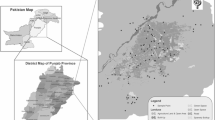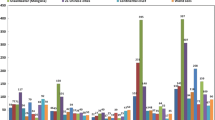Abstract
The measurement of chromium and yttrium concentration could give a chance to detect 5–10 times less chromium contamination in soil by using the yttrium normalisation method. The principle of the method is the following: elements such as chromium and yttrium exist naturally in the soil in a strongly bonded form. Therefore, in a noncontaminated area there should be a close correlation between the yttrium and chromium concentrations. If the measured Cr concentration in a sample is not on the Cr–Y trend line then the distance of plotted point from the line indicates the amount of anthropogenic chromium. Anthropogenic chromium can be detected only in the case when the contamination does not contain yttrium. This theory was tested in an agricultural–toxicological field experiment where Cr(VI) was added to the soil. Applying the yttrium normalisation method a much smaller anthropogenic effect was detected than by other evaluation methods.
Similar content being viewed by others
References
Bartha, A. and Bertalan, É.: 1997, Determination of rare earth elements of rock samples by ICP-MS using different sample decomposition methods, Acta Minerologica-Petrographica, Szeged XXXVIII, 131–149.
Crock, J.G. and Lichte, F.E.: 1982, Determination of rare earth elements in geological materials by inductively coupled argon plasma/atomic emission spectrometry, Analytical Chemistry 1329–1332.
Crock, J.G., Lichte, F.E. and Briggs, P.H.: 1983, Determination of elements in National Bureau of Standards geological reference materials SRM 278 obsidian and SRM 688 basalt by inductively coupled argon plasma-atomic emission spectrometry, Geostandards Newsletter 7, 335–340.
Crock, J.G., Lichte, F.E., Riddle, G.O. and Beech, C.L.: 1986, Separation and preconcentration of the rare-earth elements and yttrium from geological materials by ion-exchange and sequential acid elution, Talanta 33, 601–606.
Kádár I.: 1995a, Effect of heavy metal load on soil and crop, Acta Agronomica Hungarica 43, 3–9.
Kádár I.: 1995b, A talaj-növény-állat-ember tápláléklánc szennyezodése kémiai elemekkel Magyarországon/Contamination of soil-plant-animal-human food chain by chemical elements in Hungary, MTA-TAKI, Budapest.
Lichte, F.E., Allen L.M. and Crock, J.G.: 1987, Determination of rare earth elements in geological materials by inductively coupled plasma mass spectrometry, Analytical Chemistry 1150–1157.
Author information
Authors and Affiliations
Rights and permissions
About this article
Cite this article
Prokisch, J., Kovács, B., Palencsár, A.J. et al. Yttrium Normalisation: a New Tool for Detection of Chromium Contamination in Soil Samples. Environmental Geochemistry and Health 22, 317–323 (2000). https://doi.org/10.1023/A:1006799715897
Issue Date:
DOI: https://doi.org/10.1023/A:1006799715897




